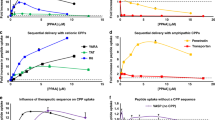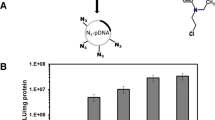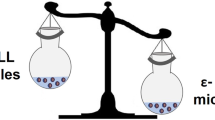Abstract
Cationic copolymers consisting of polycations linked to non-ionic polymers are evaluated as non-viral gene delivery systems. These copolymers are known to produce soluble complexes with DNA, but only a few studies have characterized the transfection activity of these complexes. This work reports the synthesis and characterization of a series of cationic copolymers obtained by grafting the polyethyleneimine (PEI) with non-ionic polyethers, poly (ethylene oxide) (PEO) or Pluronic 123 (P123). The PEO–PEI conjugates differ in the molecular mass of PEI (2 kDa and 25 kDa) and the degree of modification of PEI with PEO. All of these conjugates form complexes upon mixing with plasmids, which are stable in aqueous dispersion for several days. The sizes of the particles formed in these systems vary from 70 to 200 nm depending on the composition of the complex. However, transfection activity of these systems is much lower than that of PEI (25 kDa) or Superfect as assessed in in vitro transfection experiments utilizing a luciferase reporter expression in Cos-7 cells as a model system. In contrast, conjugate of P123 with PEI (2 kDa) mixed with free P123 (9:1(wt)) forms small and stable complexes with DNA (110 nm) that exhibit high transfection activity in vitro. Furthermore, gene expression is observed in spleen, heart, lungs and liver 24 h after i.v. injection of this complex in mice. Compared to 1,2-bis(oleoyloxy)-(trimethylammonio) propane:cholesterol (DOTAP:Chol) and PEI (25 kDa) transfection systems, the P123-PEI system reveals a more uniform distribution of gene expression between these organs, allowing a significant improvement of gene expression in liver.
This is a preview of subscription content, access via your institution
Access options
Subscribe to this journal
Receive 12 print issues and online access
$259.00 per year
only $21.58 per issue
Buy this article
- Purchase on Springer Link
- Instant access to full article PDF
Prices may be subject to local taxes which are calculated during checkout








Similar content being viewed by others
References
Rolland A, Felgner P (eds) . Non-viral gene delivery systems Adv Drug Del Rev 1998 30: 1–227
Kabanov AV, Felgner PL, Seymour LW (eds) . Self-Assembling Complexes for Gene Delivery. From Laboratory to Clinical Trial John Wiley: Chichester 1998
Garnett M . Gene delivery systems using cationic polymers Crit Rev Ther Drug Carr Sys (in press)
Boussif O et al. A versatile vector for gene and oligonucleotide transfer into cells in culture and in vivo: polyethyleneimine Proc Natl Acad Sci USA 1995 92: 7297–7301
Goula D et al. Polyethyleneimine-based intraveneous delivery of transgenes to mouse lung Gene Therapy 1998 5: 1291–1295
Kabanov AV, Kabanov VA . DNA complexes with polycations for the delivery of genetic material into cells Bioconj Chem 1995 6: 7–20
Kabanov AV, Vinogradov SV, Suzdaltseva YuG, Alakhov VY . Water-soluble block polycations for oligonucleotide delivery Bioconj Chem 1995 6: 639–643
Wolfert MA et al. Characterization of vector for gene therapy formed by self-assembly of DNA with synthetic block copolymers Hum Gene Ther 1996 7: 2123–2133
Kataoka K et al. Spontaneous formation of polyion complex micelles with narrow distribution from antisense oligonucleotide and cationic copolymer in physiological saline Macromolecules 1996 29: 8556–8557
Katayose S, Kataoka K . Water-soluble polyion complex associates of DNA and poly(ethylene glycol)-poly(L-lysine) block copolymer Bioconj Chem 1997 8: 702–707
Vinogradov SV, Bronich TK, Kabanov AV . Cationic copolymers of the delivery of antisense oligonucleotides Bioconj Chem 1998 9: 805–812
Choi YH et al. Polyethylene glycol-grafted poly-L-lysine as polymeric gene carrier. J Contr Rel 1998 54: 39–48
Maruyama A, Katoh M, Ishihara T, Akaike T . Comb-type polycations effectively stabilize DNA triplex Bioconj Chem 1997 3: 3–6
Mundigl O et al. The role of amphiphysin in neurite outgrowth J Neurosci 1998 18: 93–103
Roy S et al. Reduction of fibronectin expression by intravitreal administration of antisense oligonucleotides Nature Biotech 1999 17: 476–479
Lasic D, Martin F (eds) . Stealth Liposomes CRC Press: Boca Raton 1995
Alakhov VY, Kabanov AV . Block copolymeric biotransport carriers as versatile vehicles for drug delivery Exp Op Invest Drugs 1998 7: 1453–1473
Astafieva I et al. Enhancement of the polycation-mediated DNA uptake and cell transfection with Pluronic P85 block copolymer FEBS Lett 1996 389: 278–280
Simões S et al. Gene delivery by negatively charged ternary complexes of DNA, cationic liposomes and tranferrin or fusogenic peptides Gene Therapy 1998 5: 955–964
Stern M et al. The effects of jet nebulization on cationic liposome-mediated gene transfer in vitro Gene Therapy 1998 5: 583–593
Templeton NS et al. Novel DNA:liposome complexes for increased systemic delivery and gene expression Nature Biotech 1997 15: 647–452
Li S, Huang L . In vivo gene transfer via intravenous administration of cationic lipid-protamine-DNA (LPD) complexes Gene Therapy 1997 4: 891–900
Seymour LW, Kataoka K, Kabanov AV . Cationic block copolymers as self-assembling vectors for gene delivery. In: Kabanov AV, Felgner P, Seymour LW (eds) Self-Assembling Complexes for Gene Delivery. From Laboratory to Clinical Trial John Wiley: Chichester 1998 pp 219–239
Tang M, Szoka Jr FC . The influence of polymer structure on the interactions of cationic polymers with DNA and the morphology of the resulting complexes Gene Therapy 1997 4: 823–832
Wagner E, Cotten M, Foisner R, Birnstiel ML . Transferrin-polycation-DNA complexes: the effect of polycations on the structure of the complex and DNA delivery to cells Proc Natl Acad Sci USA 1991 88: 4255–4259
Ogris M et al. The size of DNA/transferrin-PEI complexes is an important for gene expression in cultured cells Gene Therapy 1998 5: 1425–1433
Kabanov AV, Szoka FC, Seymour LW . Interpolyelectrolyte complexes for gene delivery: polymer aspects of transfection activity. In: Kabanov AV, Felgner P, Seymour LW (eds) Self-Assembling Complexes for Gene Delivery. From Laboratory to Clinical Trial John Wiley: Chichester 1998 pp 197–218
Alexandridis P, Holzwarth JF, Hatton TA . Micellization of poly(ethylene oxide)-poly(propylene oxide)-poly(ethylene oxide) triblock copolymers in aqueous solutions: thermodynamic of copolymer association Macromolecules 1994 27: 2414–2425
Liu F, Yang J, Huang L, Liu D . Effect of non-ionic surfactants on the formation of DNA/emulsion complexes and emulsion-mediated gene transfer Pharm Res 1996 13: 1642–1646
March K, Madison JE, Trapnell BC . Pharmacokinetics of adenoviral vector-mediated gene delivery to vascular smooth muscle cells: modulation by poloxamer 407 and implications for cardiovascular gene therapy Hum Gene Ther 1995 6: 41–53
Mahato RI et al. Physicochemical and pharmacokinetics of plasmid DNA/cationic liposomes complexes J Pharm Sci 1995 84: 1267–1271
Liu Y et al. Factors influencing the efficiency of cationic liposome-mediated intravenous delivery Nat Biotech 1997 15: 167–173
Ferrari M, Fornasiero MC, Isetta AM . MTT colorimetric assay for testing macrophage cytotoxic activity in vitro J Immunol Meth 1990 131: 165–172
Acknowledgements
The National Science Foundation (BES-9712657) and Nebraska Research Initiative (Gene Therapy) in part supported the work in UNMC. Supratek Pharma Inc sponsored the synthesis and characterization of the cationic copolymers. M-H-W Laboratories (Phoenix, AZ) did elemental analysis. R Vaughn (UNMC) carried out the electron microscopy experiments. Core laboratories at UNMC also carried out the NMR measurements. We would like to thank BASF for the gift of Pluronic P123 and Quantum Biotechnologies Inc (Montreal, PQ, Canada) for the gift of the DOTAP:Chol transfection reagent and Dr Albert Descoteaux (Armand Frappier Institute, Montreal, PQ, Canada) for providing pCMV-luc plasmid.
Author information
Authors and Affiliations
Rights and permissions
About this article
Cite this article
Nguyen, HK., Lemieux, P., Vinogradov, S. et al. Evaluation of polyether-polyethyleneimine graft copolymers as gene transfer agents. Gene Ther 7, 126–138 (2000). https://doi.org/10.1038/sj.gt.3301052
Received:
Accepted:
Published:
Issue Date:
DOI: https://doi.org/10.1038/sj.gt.3301052
Keywords
This article is cited by
-
Triazine-cored polymeric vectors for antisense oligonucleotide delivery in vitro and in vivo
Journal of Nanobiotechnology (2020)
-
The potential of micelleplexes as a therapeutic strategy for osteosarcoma disease
3 Biotech (2020)
-
miR-29b and retinoic acid co-delivery: a promising tool to induce a synergistic antitumoral effect in non-small cell lung cancer cells
Drug Delivery and Translational Research (2020)
-
Design and development of a robust photo-responsive block copolymer framework for tunable nucleic acid delivery and efficient gene silencing
Polymer Journal (2018)
-
Optimized polyethylenimine (PEI)-based nanoparticles for siRNA delivery, analyzed in vitro and in an ex vivo tumor tissue slice culture model
Drug Delivery and Translational Research (2017)



